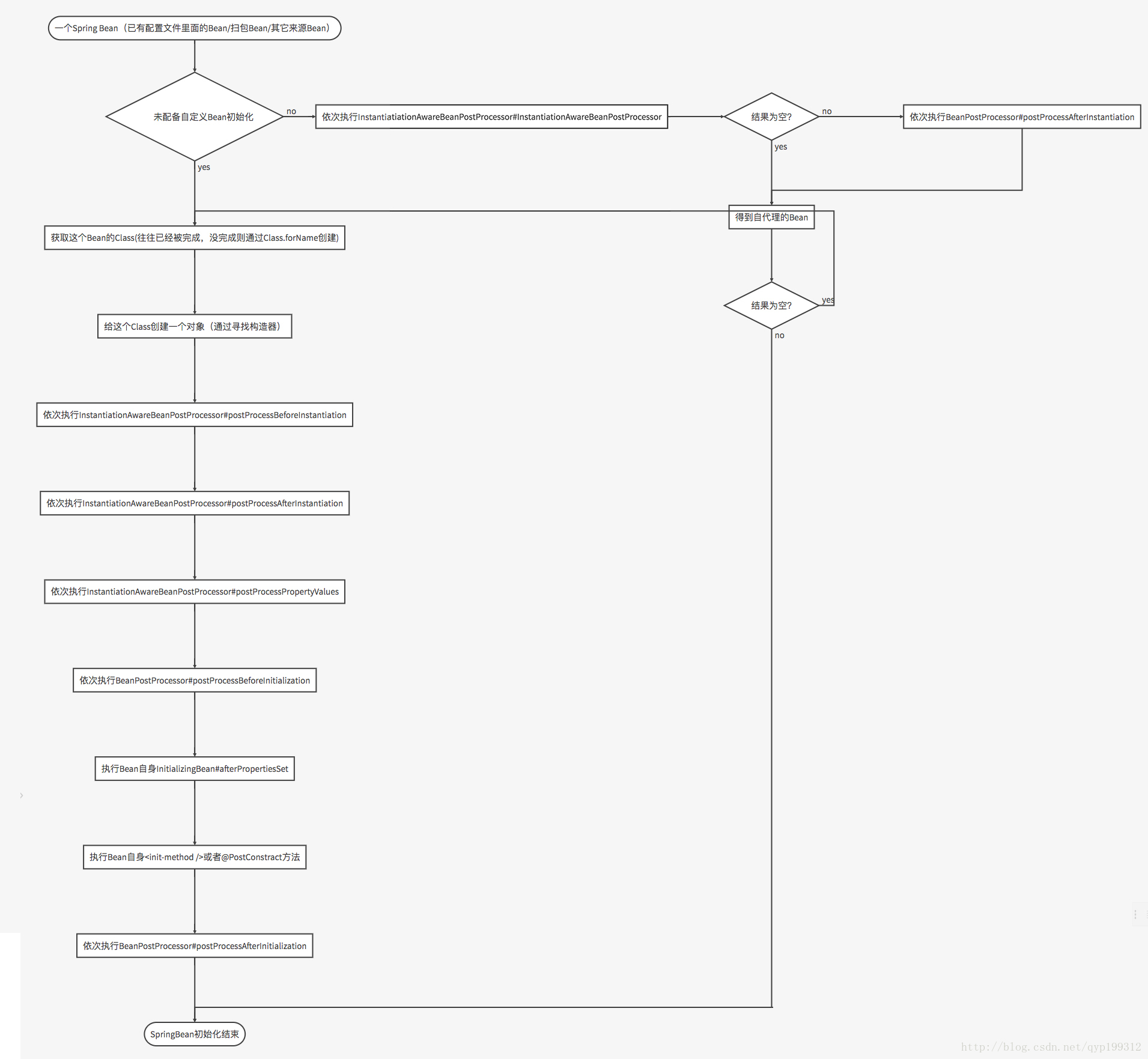前言
Spring提供配置解析功能,就是这种:
<bean id="dataSource" class="com.alibaba.druid.pool.DruidDataSource"
init-method="init" destroy-method="close">
<property name="url" value="${jdbc.url}"/>
<property name="username" value="${jdbc.username}"/>
<property name="password" value="${jdbc.password}"/>
</bean>或者是这种:
@Value("${spring_only}")
private String springOnly;可以很方便的通过配置XML来实现对Classpath下的配置文件的注入。
在Spring3.1版本之前是通过PropertyPlaceholderConfigurer实现的。
而3.1之后则是通过PropertySourcesPlaceholderConfigurer 实现的。
PropertyPlaceholderConfigurer 和 PropertyPlaceholderConfigurer 在使用上并无本质的区别。两者的根本目标是将配置文件生成KV对。 真正的注入工作并不由它们本身执行。
Spring生命周期
配置可以实现注入, 则必须得遵从Spring生命周期。Spring Bean的生命周期可以参考。
如下图(图片来源:http://blog.csdn.net/qyp199312/article/details/60762194)
途中的
实例化指的是生成一个Java的对象。
元素注入时机
元素的注入依赖于 AutowiredAnnotationBeanPostProcessor#postProcessPropertyValues1。 通过解析了的PropertySourcesPlaceholderConfigurer 查询得到元素值。 没有则抛出异常。如下源码:
源码摘自 DefaultListableBeanFactory#doResolveDependency
// 获取注解的 value() 值。被写死为 Class<? extends Annotation> valueAnnotationType = Value.class;
// 见类 QualifierAnnotationAutowireCandidateResolver
Object value = getAutowireCandidateResolver().getSuggestedValue(descriptor);
if (value != null) {
if (value instanceof String) {
// 通过PropertySourcesPlaceholderConfigurer写入的键值对元素获取元素的值.
// 方法内注册了多个StringValueResolver,循环查找值。提供者为PropertySourcesPlaceholderConfigurer,因此配置多个解析器的时候是以最后的配置为准的。
String strVal = resolveEmbeddedValue((String) value);
BeanDefinition bd = (beanName != null && containsBean(beanName) ? getMergedBeanDefinition(beanName) : null);
value = evaluateBeanDefinitionString(strVal, bd);
}
TypeConverter converter = (typeConverter != null ? typeConverter : getTypeConverter());
return (descriptor.getField() != null ?
converter.convertIfNecessary(value, type, descriptor.getField()) :
converter.convertIfNecessary(value, type, descriptor.getMethodParameter()));
}元素注入的序列图如下:
在Spring初始化流程中,执行
AbstractApplicationContext#finishBeanFactoryInitializatin方法。 该方法里面发生的主要流程为Spring 业务 Bean初始化。 实际流程跟Spring Bean的初始化没有任务区别。
通过对接口InstantiationAwareBeanPostProcessor实现类的方法进行执行。 仅此而已
可以看出
PropertySourcesPlaceholderConfigurer或者PropertyPlaceholderConfigurer仅仅是做了一个配置文件的解析工作,真正的注入并不由它们完成,而是托付给了Spring 的Bean初始化流程。
之所以这么做可以生效,是因为这两个类实现了BeanFactoryPostProcessor接口,这个接口的优先级高于后续的Spring Bean。
数据来源
配置Bean方式
单个配置文件
<bean id="propertyConfigurer"class="org.springframework.beans.factory.config.PropertyPlaceholderConfigurer">
<property name="location">
<value>conf/sqlmap/jdbc.properties</value>
</property>
<property name="fileEncoding">
<value>UTF-8</value>
</property>
</bean>多个配置文件
<bean id="propertyConfigurer"class="org.springframework.beans.factory.config.PropertyPlaceholderConfigurer">
<property name="locations">
<list>
<value>/WEB-INF/mail.properties</value>
<value>classpath: conf/sqlmap/jdbc.properties</value>//注意这两种value值的写法
</list>
</property>
</bean>其中PropertyPlaceholderConfigurer是Spring3.1之前使用的。
PropertySourcesPlaceholderConfigurer是Spring3.1之后使用的。
写法都类似
Spring标签方式
<context:property-placeholder location="classpath*:/WEB-INF/mail.properties" />这总方式的原理就是构造一个PropertySourcesPlaceholderConfigurer, (3.1之前是PropertyPlaceholderConfigurer)
- ContextNamespaceHandler#init
- PropertyPlaceholderBeanDefinitionParser#doParse
触发点为:
AbstractApplicationContext#obtainFreshBeanFactory 。Spring初始化Context的时候读取XML配置(基于XML), 这个流程优先于Spring 普通Bean初始化。配合扫包(<context:component-scan />)得到的Bean进而实现对XML里面配置的Bean的载入。
PropertySourcesPlaceholderConfigurer本质上是一个BeanFactoryPostProcessor。解析XML的流程在BeanFactoryPostProcessor之前, 优先将配置文件的路径以及名字通过Setter传入PropertySourcesPlaceholderConfigurer。
如上BeanFactoryPostProcessor的优先级又优于其余的Bean。因此可以实现在bean初始化之前的注入。
引申mybatis数据源配置
通常在配置mybatis的时候,配置 org.mybatis.spring.mapper.MapperScannerConfigurer需要使用<property name="sqlSessionFactoryBeanName" value="sqlSessionFactoryAccount" /> 参数实现SqlSessionFactory的注入。
这是由于MapperScannerConfigurer 本质上也是一个 BeanFactoryPostProcessor。 而SqlSessionFactory往往只是一个普通的Spring Bean, 它的优先级是低于 MapperScannerConfigurer 的, 如果在初始化 MapperScannerConfigurer 的时候去寻找SqlSessionFactory, 肯定是会报依赖错误的, 因此之后在后续的流程中实现注入。
发生找不到配置的情况
在工作中我们会习惯性的使用多个Spring配置文件, 例如spring.xml/spring-db.xml/spring-web.xml灯。 里面就配置多个Spring标签,或者多个 PropertySourcesPlaceholderConfigurer 。但是时常会发生找不到配置的情况。
为什么<context:property-placeholder />优先级更高
因为基于XML配置的Spring, 不管是<context:property-placeholder />还是 <Bean />标签都依赖于 NamespaceHandler去解析。 而<context:property-placeholder />在解析完毕之后就已经生成了 PropertySourcesPlaceholderConfigurer , <Bean />标签还需要等待后续流程。
为什么PropertySourcesPlaceholderConfigurer唯一
这里的”为什么”, 指的不是它为什么这么设计,而是为什么会有这么样的结果。
另外PropertySourcesPlaceholderConfigurer并不唯一,只是在对外体现上后续的配置无法去到值,因此看起来是唯一的。
PropertySourcesPlaceholderConfigurer Bean的唯一是由Java web特性和Spring本身的设计决定的。
- Servlet的启动,在web.xml中Listener串行单线程启动。
- Spring内置的Bean模式为单例模式。
- Spring在初始化的时候会直接将需要的Bean给初始化成功。
- 启动的先后顺序依赖于它们在 xml 里面配置的上下关系。
不管 <context:property-placeholder />或者PropertySourcesPlaceholderConfigurer或者PropertyPlaceholderConfigurer方式配置的配置解析器,其本质就是得到一个 BeanFactoryPostProcessor, 并执行其 #postProcessBeanFactory(ConfigurableListableBeanFactory)方法。
其执行的根本目的在于 PlaceholderConfigurerSupport#doProcessProperties(ConfigurableListableBeanFactory, StringValueResolver )。
protected void doProcessProperties(ConfigurableListableBeanFactory beanFactoryToProcess,
StringValueResolver valueResolver) {
// ignore
....
// New in Spring 2.5: resolve placeholders in alias target names and aliases as well.
beanFactoryToProcess.resolveAliases(valueResolver);
// New in Spring 3.0: resolve placeholders in embedded values such as annotation attributes.
// 目的是为了添加解析器
beanFactoryToProcess.addEmbeddedValueResolver(valueResolver);
}这里的 addEmbeddedValueResolver(StringValueResolver) 是为一个 LinkedList添加值。
在取用的时候是优先从链表头开始取用的。 一旦发现无法找到值,直接就抛异常了。这个就对外体现出 PropertySourcesPlaceholderConfigurer 的唯一性。 (然而Spring内部还是有多个PropertySourcesPlaceholderConfigurer, 只不过除了排列在队首的 PropertySourcesPlaceholderConfigurer 之外全都被忽略掉了 )。
总结Spring Value注入流程
最后的总结:
配置Spring @Value("val2Inject") 方式获取配置文件的属性,需要依赖于在Spring XML里面配置<context:property-placeholder /> 或者PropertySourcesPlaceholderConfigurerBean来添加配置文件的名称。流程如下:
- Spring Context 的初始化开始
- 读取到
context:property-placeholder标签或者PropertySourcesPlaceholderConfigurer - 解析并实例化一个
PropertySourcesPlaceholderConfigurer。同时向其中注入配置文件路径、名称 PropertySourcesPlaceholderConfigurer自身生成多个StringValueResolver备用,Bean准备完毕- Spring在初始化非
BeanFactoryPostProcessor的Bean的时候,AutowiredAnnotationBeanPostProcessor负责找到Bean内有@Value注解的Field或者Method - 通过
PropertySourcesPlaceholderConfigurer寻找合适的StringValueResolver并解析得到val值。注入给@Value的Field或Method。(Method优先)2 - Spring的其他流程。







 本文详细介绍了Spring框架中配置文件的注入流程,包括不同版本中PropertySourcesPlaceholderConfigurer的作用及其实现原理,以及@Value注解的注入流程。
本文详细介绍了Spring框架中配置文件的注入流程,包括不同版本中PropertySourcesPlaceholderConfigurer的作用及其实现原理,以及@Value注解的注入流程。

















 413
413

 被折叠的 条评论
为什么被折叠?
被折叠的 条评论
为什么被折叠?








